November 2014 LIP of the Month
The Mount Rogers Formation: Bimodal volcanism related to Cryogenian rifting of the eastern Laurentian margin of Rodinia
Elizabeth McClellana, and Esteban Gazelb
a Department of Geology, Radford University, P.O. Box 6939, Radford, VA 24142
b Department of Geosciences, Virginia Tech, 5041Derring Hall (0420), Blacksburg, VA 24061
Extracted and modified from, and full details provided in:
McClellan, E.A., and Gazel, E., 2014, The Cryogenian intra-continental rifting of Rodinia: Evidence from the Laurentian margin in eastern North America. Lithos, v. 206, 321-337. DOI: 10.1016/j.lithos.2014.08.006.
INTRODUCTION
The Neoproterozoic (~760-750 Ma) Mount Rogers Formation represents the largest preserved eruptive facies of a bimodal, dominantly silicic LIP that formed during an early stage of intracontinental rifting of the eastern margin of North America (Laurentia), during breakup of Rodinia. The geologic history of the eastern North American margin encompasses two complete Wilson cycles that brought about the assembly and subsequent disaggregation of two supercontinents, Rodinia and Pangea. During breakup of Pangea, the rift-to-drift transition along the margin began with rifting in southeastern North America at ca. 230 Ma, followed by rapid emplacement of mafic magmas as flood basalts and dikes at 200 Ma, and initial seafloor spreading at 190-170 Ma (e.g., Schettino and Turco, 2009; Labails et al., 2010). In contrast to the <50 million-year duration of events leading to the initial opening of the Central Atlantic, fragmentation of the eastern Laurentian margin of Rodinia was a protracted event that spanned ~ 200 million years, from early intracontinental rifting to the onset of seafloor spreading. Magmatic activity associated with final breakup of Rodinia and opening of the Iapetus Ocean is broadly referred to as the Central Iapetus magmatic event (Ernst and Buchan, 1997). Basaltic rocks were emplaced during three pulses, including the 615 Ma Long Range dikes in Newfoundland and southeastern Labrador, the 590 Ma Grenville dike swarm, and the 565-555 Ma Catoctin volcanics and related intrusions (Puffer, 2002; Ernst and Bleeker, 2010). The Central Iapetus magmatic event was preceded by Cryogenian (ca. 765-680 Ma) intracontinental rifting and magmatism. During this phase, the Mesoproterozoic continental crust was intruded by numerous A-type felsic plutons and extensional mafic dikes. At ~760-750 Ma a bimodal volcanic sequence, known as the Mount Rogers Formation, erupted onto the uplifted and eroded basement. In this contribution, we summarize the stratigraphy and geochemical characteristics of the Mount Rogers volcanic rocks. We then use the data and field relationships to explore the origin of the Cryogenian magmatism along the eastern Laurentian margin.
REGIONAL GEOLOGY
In the Blue Ridge province of the southern and central Appalachian region, rocks that record the Proterozoic history occur primarily in two allochthonous, fault-bounded inliers, the French Broad and Shenandoah massifs (Fig. 1). These two inliers together extend >700 km along strike, and expose Mesoproterozoic basement rocks unconformably overlain by Neoproterozoic to early Cambrian volcanic and sedimentary deposits. Crystallization ages of basement gneisses and granitoids of 1.3-1.0 Ga correspond to the timing of Grenville collisional orogenic events (McLelland et al., 1996) related to assembly of Rodinia (Carrigan et al., 2003; Tollo et al., 2004a, 2010). The basement rocks of the Blue Ridge province were subsequently affected by two episodes of crustal extension separated by >100 m.y.: a Cryogenian phase spanning the interval 765-700 Ma, and an Ediacaran event at ~565 Ma (Badger and Sinha, 1988; Aleinikoff et al., 1995). The latter event produced extensive flood basalts, with intercalated rhyolites, of the Catoctin Formation (Reed, 1955; Badger and Sinha, 1988), which record fragmentation of Rodinia (Badger et al. 2010) and opening of the Iapetus Ocean (Wehr and Glover, 1985; Aleinikoff et al., 1995). During the earlier Cryogenian phase, numerous A-type felsic plutons and extensional mafic dikes were emplaced into the Mesoproterozoic basement (e.g., Goldberg et al., 1986; Tollo et al., 2004b). Eruptive volcanic rocks related to the Cryogenian magmatic event are best preserved in the Mount Rogers area of the French Broad massif (Fig. 1). The Mount Rogers Formation (Rankin, 1970; 1993) comprises a bimodal basalt-rhyolite lower section, and an upper section of dominantly peralkaline rhyolitic sheets (Fig. 2). The contact of the Mount Rogers Formation with underlying 1.3-1.0 billion year old basement granitoid rocks (Tollo et al., 2012) is interpreted as an unconformity (Rankin 1993), although presently is a fault (Bailey and Rose, 1998) or a sheared unconformity (McClellan et al. 2012a).
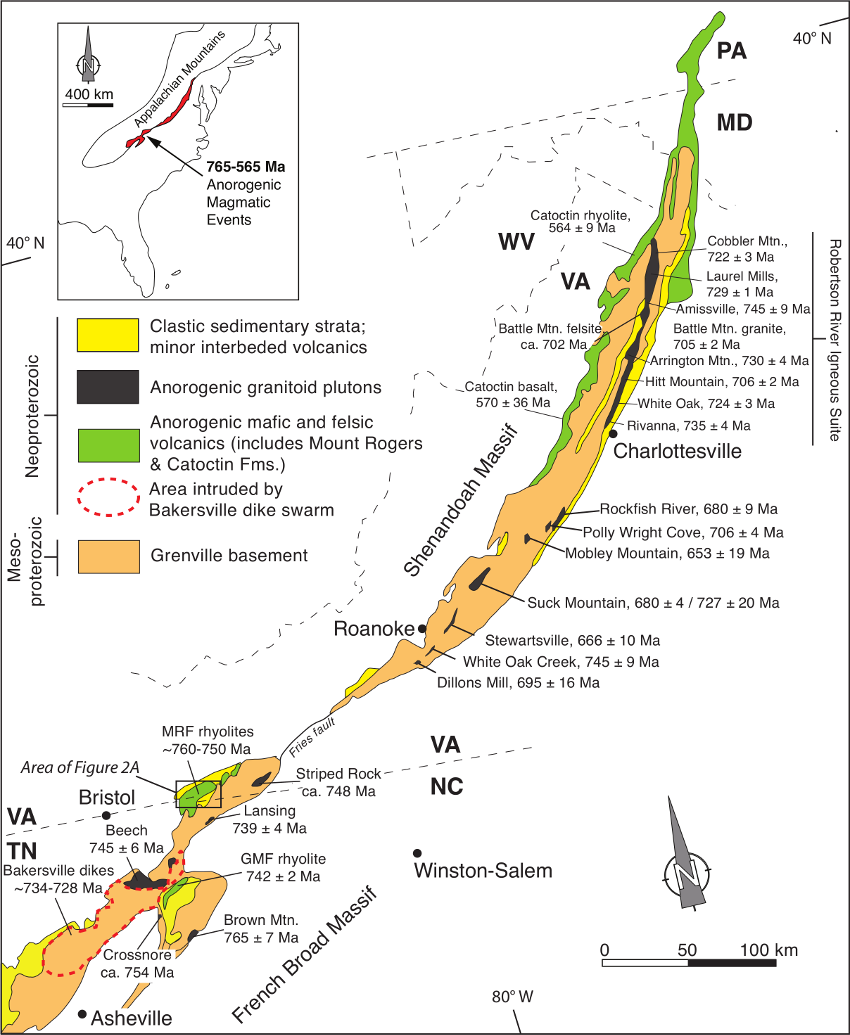
Fig. 1. Neoproterozoic anorogenic magmatic events along the Laurentian margin of eastern North America during breakup of Rodinia, as represented by plutonic and volcanic rocks presently exposed in the French Broad and Shenandoah massifs of the Appalachian Blue Ridge. Modified from Burton and Southworth (2010) and Tollo et al. (2012). Isotopic ages from Aleinikoff et al., 1995; Badger and Sinha, 1988; Essex, 1992; Fetter and Goldberg, 1995; Fokin, 2003; Goldberg et al., 1986; Ownby et al., 2004; Southworth et al., 2009; Tollo and Aleinikoff, 1996; Tollo et al., 2004b. Locations and details can be found in McClellan and Gazel, 2014, Table 1.
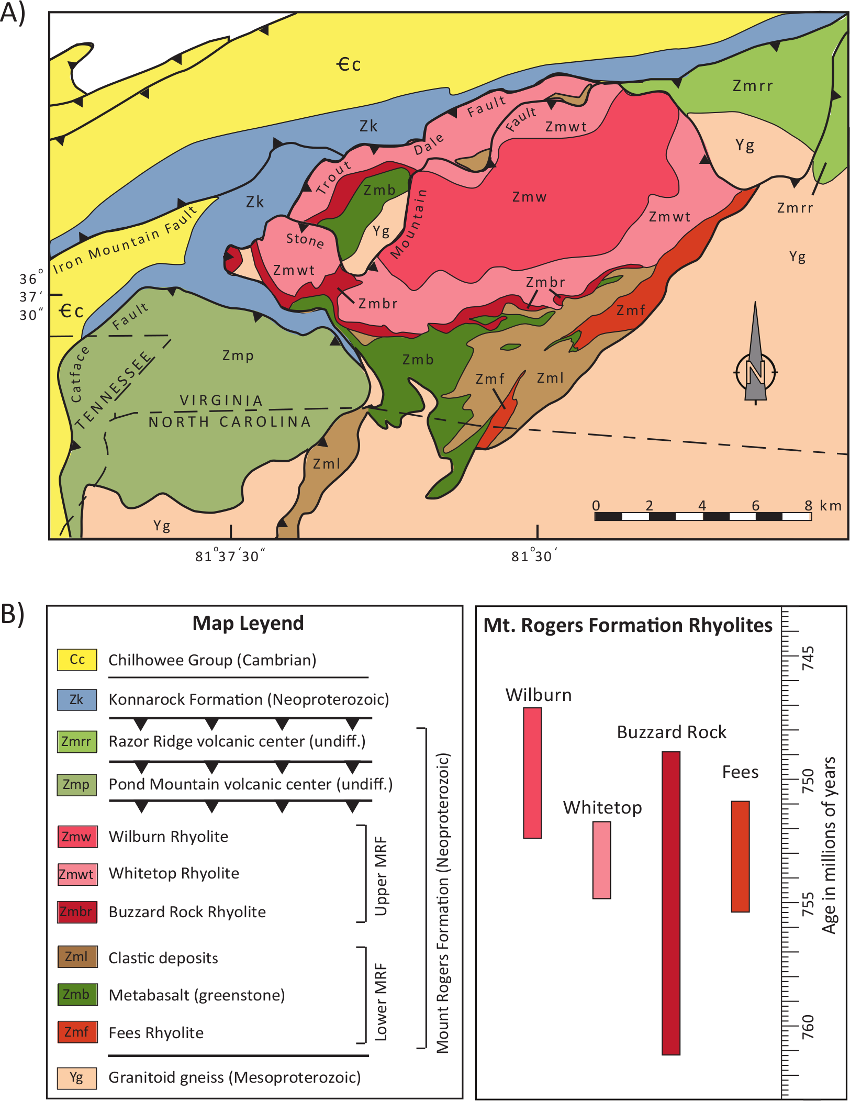
Fig. 2. A. Geological map of Mount Rogers Formation, modified from Rankin (1993). Contacts in the lower Mount Rogers Formation from this study. Placement of the Stone Mountain fault in North Carolina from Baily and Rose (1998). B. Uranium-lead zircon CA-TIMS ages of rhyolites from the Mount Rogers Formation (Tollo et al., 2012). Bars represent preferred ages within error: Fees - 753.1 +/- 2.7 Ma; Buzzard Rock - 755.0 +/- 6.6 Ma; Whitetop - 753.3 +/- 2.0 Ma; Wilburn Ridge - 749.7 +/- 3.1 Ma.
Rhyolites, with associated basalts and clastic sedimentary deposits, also occur in two volcanic centers that are structurally removed from the main body of the Mount Rogers Formation (Rankin, 1993) (Fig. 2). The Razor Ridge volcanic center crops out to the east and is at least in part dissected by faults, whereas the Pond Mountain volcanic center occurs solely in the Catface thrust sheet, west of and structurally below the Stone Mountain thrust sheet (Bailey and Rose, 1998; Merschat and Southworth, 2011; Rubin and Tollo, 2012; Tollo et al., 2012). The Mount Rogers Formation is overlain by the Konnarock Formation (Fig. 2), a sequence of sedimentary rocks interpreted as Cryogenian glaciogenic deposits (Blondeau and Lowe, 1972; Schwab, 1976; Miller, 1989; Rankin, 1993). Merschat and Southworth, (2011) mapped volcaniclastic deposits and rhyolite of the Razor Ridge volcanic center grading into and interbedded with laminated mudstone of the Konnarock Formation, suggesting essentially contemporaneous volcanic activity and glaciation.
Stratigraphy of the Mount Rogers Formation
The Mount Rogers Formation is divided into an upper section dominated by rhyolitic volcanic rocks, and a lower sequence comprising bimodal volcanics intermixed with clastic sedimentary rocks (Fig. 2). The upper Mount Rogers Formation rhyolites were mapped and described in detail by Rankin (1993), and have been the subject of later studies (Novak and Rankin, 2004; Tollo et al., 2012). Rankin (1993) also formalized the Fees Rhyolite Member of the lower Mount Rogers Formation, although did not differentiate the remainder of the lower section. Our recent mapping has focused on detailing the stratigraphy of the lower Mount Rogers (McClellan et al., 2011; 2012a; 2012b; McClellan and Gazel, 2014), as is summarized herein. Petrographic descriptions of all units can be found in Table S1 of the supplementary material that accompanies McClellan and Gazel (2014).
Volcanic and clastic sedimentary rocks of the Mount Rogers Formation were metamorphosed to lower greenschist facies during Paleozoic collisional tectonism (Rankin, 1993). Despite the metamorphic overprint and locally intense foliation development, identification of protoliths is generally straightforward. Therefore, the prefix ‘meta-‘ will be omitted in the descriptions below. Thickness estimates are included, but are imprecise due to complex deformation throughout the unit and subsequent erosion.
Upper Mount Rogers Formation
Detailed descriptions of the upper Mount Rogers Formation can be found in Rankin (1993). The formation is divided into three rhyolite units (Fig. 2), with an estimated total thickness of approximately 1850 m. Aleinikoff et al. (1995) obtained a U-Pb zircon age of 758 ± 12 Ma for the Whitetop Rhyolite. More recently, Tollo et al. (2012) reported CA (chemical abrasion)-TIMS zircon ages for all three units, ranging from ~750-755 Ma (Fig. 2). The uppermost Wilburn Rhyolite is a well-preserved ash-flow sheet (ignimbrite). Geochemical interpretations suggest that the magma chamber was compositionally zoned from metaluminous to peralkaline, and this relationship was inverted during eruption (Novak and Rankin, 2004). Fewer published geochemical analyses exist for the other units; however, these show that the Whitetop Rhyolite is geochemically similar to the Wilburn, whereas the Buzzard Rock Rhyolite is lower in silica and less chemically evolved (e.g., higher in FeOt, TiO2, Sc, V) than the other units (Tollo et al., 2012). Major and trace-element data indicate that the Mount Rogers rhyolites were formed in a within-plate setting, and are interpreted as part of an A-type suite of plutonic and volcanic rocks (Fig. 1) related to intracontinental rifting (Novak and Rankin, 2004; Tollo et al., 2004b; Tollo et al., 2012).
Lower Mount Rogers Formation
Fees Rhyolite
The Fees Rhyolite Member occurs at or near the base of the lower Mount Rogers Formation. First described by Rankin (1993), the rhyolite was also the subject of a study by James (1999). Our recent mapping has extended the known outcrop area of the unit (Fig. 2), and we estimate a maximum thickness of approximately 300 m (McClellan and Gazel, 2014). Single zircon CA-TIMS analysis of the Fees yielded an age of 753.1 ± 2.7 Ma (Tollo et al, 2012) (Fig. 2). The dominant rock type is a porphyritic rhyolite with prominent phenocrysts of perthitic alkali feldspar and quartz and lesser plagioclase (Fig. 3A, B), which distinguishes this unit from similar rhyolites in the upper Mount Rogers Formation (Rankin, 1993; McClellan and Gazel, 2014). Locally, fiamme are present in outcrop (Fig. 3A). Lithics within the Fees rhyolite include those of volcanic and plutonic origin. The presence of ignimbrite textures, lithic clasts, and fiamme suggest the Fees Rhyolite is dominantly pyroclastic in origin. Within its outcrop belt, the Fees Rhyolite is associated with coarse rhyolite porphyry distinguished by abundant alkali feldspar and quartz phenocrysts. Feldspars are commonly up to 1 cm or more in cross section. This lithology is similar to felsic rocks described by Rankin (1993) in the Pond Mountain volcanic center (Fig. 2), and may represent a hypabyssal intrusive.
Basalt (Greenstone)
Mafic rocks dominate the lower Mount Rogers Formation in the western part of its outcrop area (Fig. 2), and range from relatively undeformed basalt to greenstone or foliated greenschist, all having the typical chlorite and epidote assemblages characteristic of the low-grade metamorphic overprint. Several different varieties occur (Fig. 3C, D), including vesicular/amygdaloidal basalt, homogeneous aphyric greenstone or greenschist, and plagioclase-phyric basalt porphyry. The latter rock may represent a hypabyssal intrusive, but relationships in outcrop show interlayering between vesicular flows and the porphyry, suggesting an extrusive origin. In the study area thickness estimates are complicated by folding, but we estimate a minimum thickness of 1300 m. Lindsey (2010) calculated a thickness of approximately 1600 m for lower Mount Rogers Formation basalts exposed in the Trout Dale thrust sheet north of the present study area (Fig. 2).
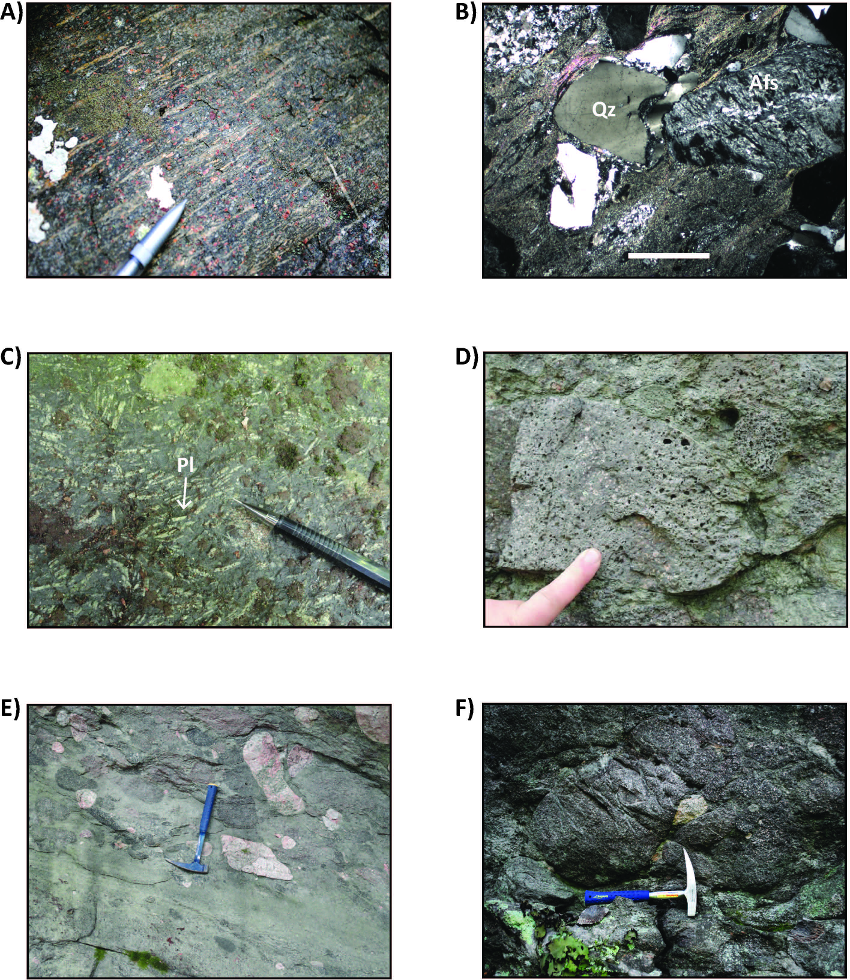
Fig. 3. Lithologies of the lower Mount Rogers Formation; all lithologies metamorphosed to lower greenschist facies. Mineral abbreviations from Whitney (2010). A. Outcrop of Fees Rhyolite with prominent aligned fiamme. B. Photomicrograph of Fees Rhyolite, characterized by phenocrysts of embayed quartz (Qz) and perthitic alkali feldspar (Afs). Scale bar = 2 mm. C. Plagioclase-phyric basalt, described as “turkey-track” texture by Rankin (1993). Pl – plagioclase. D. Basalt with vesicular texture. E. Polymict conglomerate dominated by clasts of pink granitoids (light-colored clasts) and rhyolite (dark-colored clasts). F. Clast-supported conglomerate with boulder-sized clasts of rhyolite.
Clastic Sedimentary Rocks
Volcanic rocks of the lower Mount Rogers Formation are overlain by a sequence of coarse-grained clastic rocks, comprising polymict conglomerate that grades laterally into pebbly feldspathic to lithic wacke. Ranging from grain- to matrix-supported, the conglomerate contains cobble-sized to boulder-sized clasts (Fig. 3E, F). Framework grains are dominated by rhyolite and granitoid clasts, with lesser basalt, vein quartz, jasper, and black slate. The clasts are commonly inferred to have been derived locally from the underlying rocks, and in particular, from the Fees Rhyolite and basement granitoids. However, recent age-dating of clasts from the conglomerates has challenged this assumption. Laser ablation ICP-MS zircon U-Pb analysis has revealed three age groupings of rhyolite clasts: ~780-775, ~760 Ma, and ~753 Ma (Holm-Denoma et al., 2014; McClellan and Holm-Denoma, 2014). One granitoid clast analyzed also yielded an age of ~780 Ma. The 760-753 Ma ages are consistent with ages of the Mount Rogers rhyolites. The ~780-775 Ma population of clasts, however, demonstrates that a more extensive magmatic event of longer duration existed, and the resulting rocks were uplifted and rapidly eroded.
Original bedding in the conglomerate is occasionally observed, and is defined by layers of pebbly sandstone within the conglomerate. The conglomerate grades laterally into coarse arkosic sandstones that contain granules and pebbles of vein quartz, granitoid, and rhyolite. Although the original geometry of the Mount Rogers clastic deposits has been highly modified by later tectonic deformation, major changes in lateral and vertical facies, and generally wedge-shaped geometry is still evident (Jessee et al., 2012). The clastic sedimentary rocks are interpreted as alluvial fan deposits, which likely represent a progradational sequence formed during synsedimentary faulting associated with crustal extension (McClellan et al., 2012b).
GEOCHEMISTRY
We analyzed major and trace-element data from 36 rhyolites and basaltic lavas from the lower Mount Rogers Formation; methods and the full data set can be found in McClellan and Gazel (2014) and related supplementary material. Geochemical data from upper Mount Rogers Formation rhyolites (Novak and Rankin, 2004; Tollo et al., 2012) are included in the plots for comparison. The samples are bimodal in composition, with one population of basaltic magmas that includes lava flows and feeder dikes, and another of rhyolites (Fig. 4A). The basaltic samples belong to the tholeiitic series (Fig. 4B). The few samples that plot as trachybasalts (Fig. 4A) could be the result of mobility of alkalis (Na2O, K2O) by secondary processes rather than belonging to an alkaline series, as less mobile FeO(t) (Figure 5A), and TiO2 correlate negatively with MgO as expected in tholeiitic magmas (e.g., Zimmer et al., 2010).
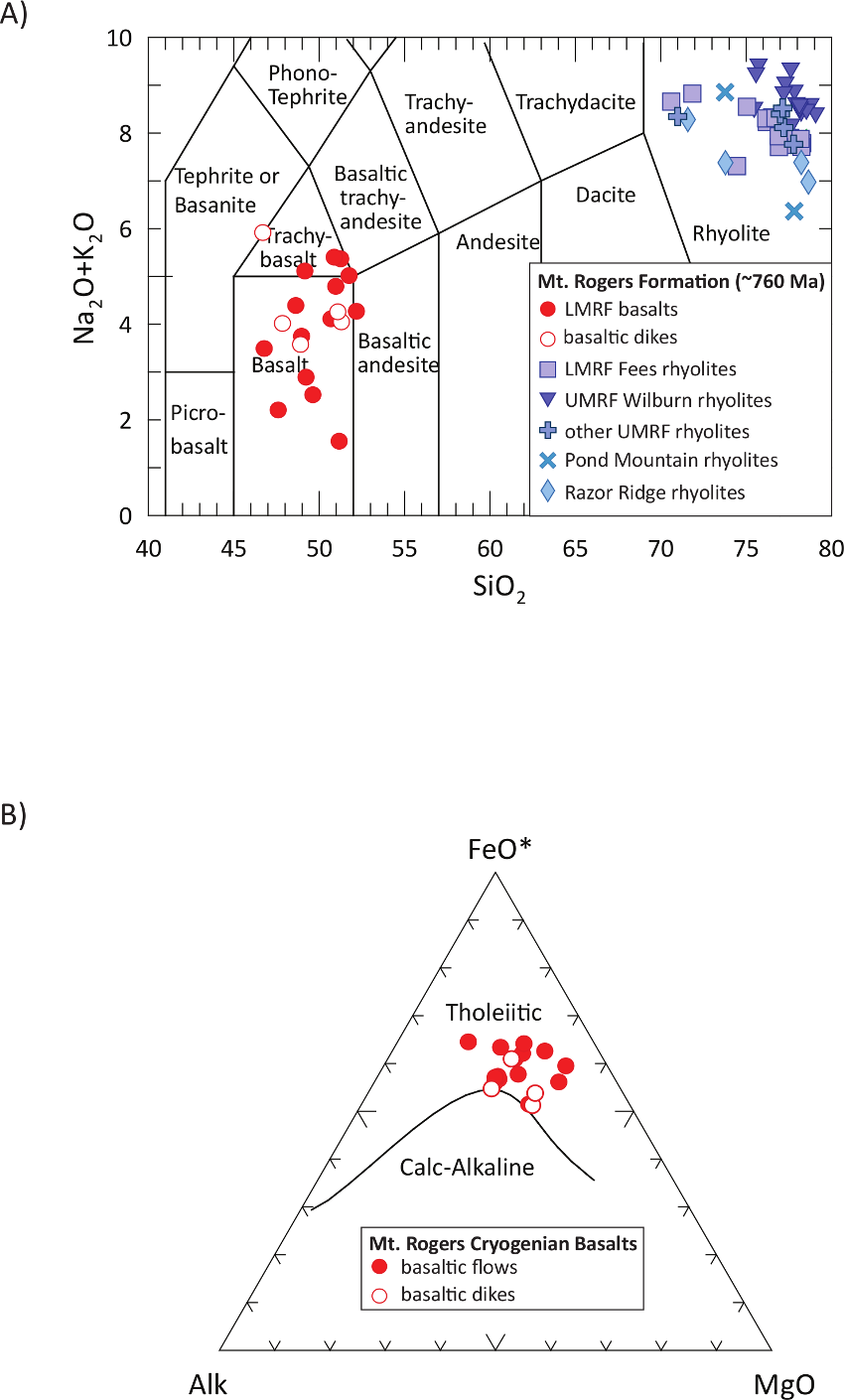
Fig. 4. Geochemical classification of the Mount Rogers Formation volcanic rocks, based on major element compositions, indicating bimodal volcanism represented by basalts and rhyolites. Samples normalized to 100% in a water-free basis. Abbreviations: LMRF – lower Mount Rogers Formation. UMRF – upper Mount Rogers Formation.
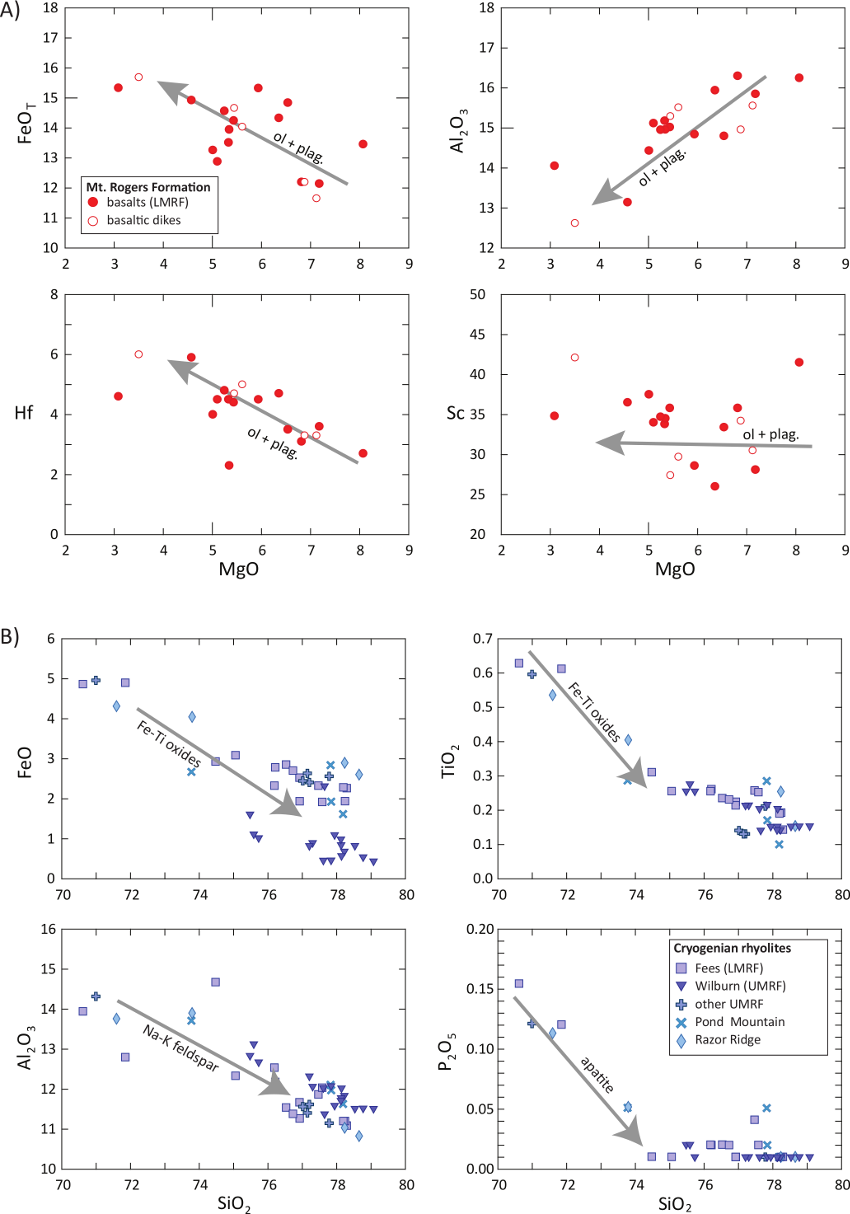
Fig. 5. Variations of major element compositions from basaltic and rhyolite samples from the Mount Rogers Formation, and inferred crystallization phases. Additional data for the upper Mount Rogers Formation from Novak and Rankin (2004) and Tollo et al. (2012). Abbreviations as in Fig. 4.
In the basaltic samples, major elements correlate negatively with increasing MgO, with the exception of CaO and Al2O3 that correlate positively, indicating fractionation of olivine and plagioclase as expected in tholeiitic suites (Fig. 5A). Trace elements mostly show a negative correlation (e.g., Hf in Fig. 5A) or do not vary with MgO (e.g., Sc in Fig. 5A). The relatively constant values of Sc, ~30-40 ppm, and the lack of correlation with MgO (Fig. 5A), suggests that the fractionation of clinopyroxene was not significant in the evolution of these samples. On multi-element diagrams (Fig. 6), samples display enrichment in highly to moderately incompatible elements, with all samples having steep rare earth element (REE) patterns (La/Yb, 5-10) and high-field strength (HFSE, Th, Nb, Ta, Zr, Ti, Y, Hf) enrichments.
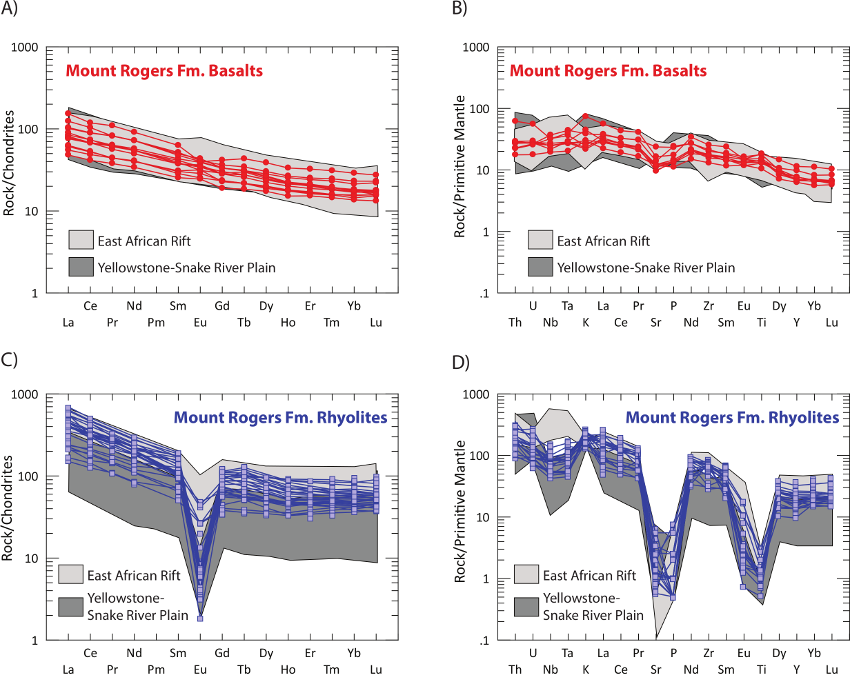
Fig. 6. Incompatible element compositions of samples from the Mount Rogers Formation. A and B are REE patterns normalized to chondrites (Sun and McDonough, 1989) and C and D are multi-element diagrams normalized to primitive mantle (McDonough and Sun, 1995). The shaded areas are samples from East African Rift and Yellowstone from the Georoc database for comparison (http://georoc.mpch-mainz.gwdg.de/georoc/).
In the rhyolites, negative correlation between major elements and SiO2 are common, controlled mostly by Na-K feldspar and Fe-Ti oxides (Fig. 5B). Steep slopes in P2O5 and TiO2 can be explained by crystallization of apatite and Fe-Ti oxides respectively (Fig. 5B). On chondrite- and primitive mantle-normalized plots (Fig. 6) the samples also present enrichments in highly to moderately incompatible elements, and steep REE patterns (La/Yb, 5-15). The rhyolite patterns show slight depletions in Nb and Ta, and significant depletions in Sr, P, Eu, Ti, that suggest the fractionation of feldspar together with apatite and Fe-Ti oxides during the evolution of these rocks (Fig. 6).
DISCUSSION
Geochemistry and magmatic processes
Although the Cryogenian volcanics from the Mt. Rogers location underwent low-grade metamorphism, they are exceptionally preserved considering the complex ~760 m.y. history of these rocks. Most of the major and trace elements are also well preserved (Fig. 5, Fig. 6), especially the REEs, the HFSE and other elements that are immobile during fluid-rock interactions (e.g. Pearce, 2008). Thus, we feel confident in using the REE and HFSE to evaluate whether there is a cogenetic relation between the two. Based on the REEs, it is clear that these samples belong to two different trends (Fig. 7A). The basaltic samples belong to the tholeiitic series (Fig. 4B), controlled by crystallization of olivine and plagioclase. These suggest that the parental magma was relatively dry in composition as observed today in MORB and some intraplate settings (Zimmer et al. 2010). Both the basalts and the rhyolites have steep REE patterns in chondrite-normalized plots (Fig. 6 A and B). In the basaltic samples, the variation in heavy REE between the different samples is probably related to melting depth, with the most depleted (Sm/Yb >2) being produced in the garnet stability field (Green and Ringwood, 1967; Hofmann and Feigenson, 1983; Johnson, 1998). (Fig. 7A). Based on normalization to a primitive mantle reference (Fig. 6B), the magmas that produced the Cryogenian basalts show incompatible element patterns controlled by upwelling asthenosphere, as they are enriched in LREE and HFSE (e.g. positive Nb, Ta, Ti), typical of intraplate magmas (Hofmann, 1997; Pearce, 2008; Jackson et al., 2008). The asthenospheric signature of the mafic magmas is confirmed by end-members having Nb/U (Fig. 7B) values between 40-60, characteristic of melts derived from upwelling asthenosphere in MORB and OIB settings (Hofmann et al., 1986).
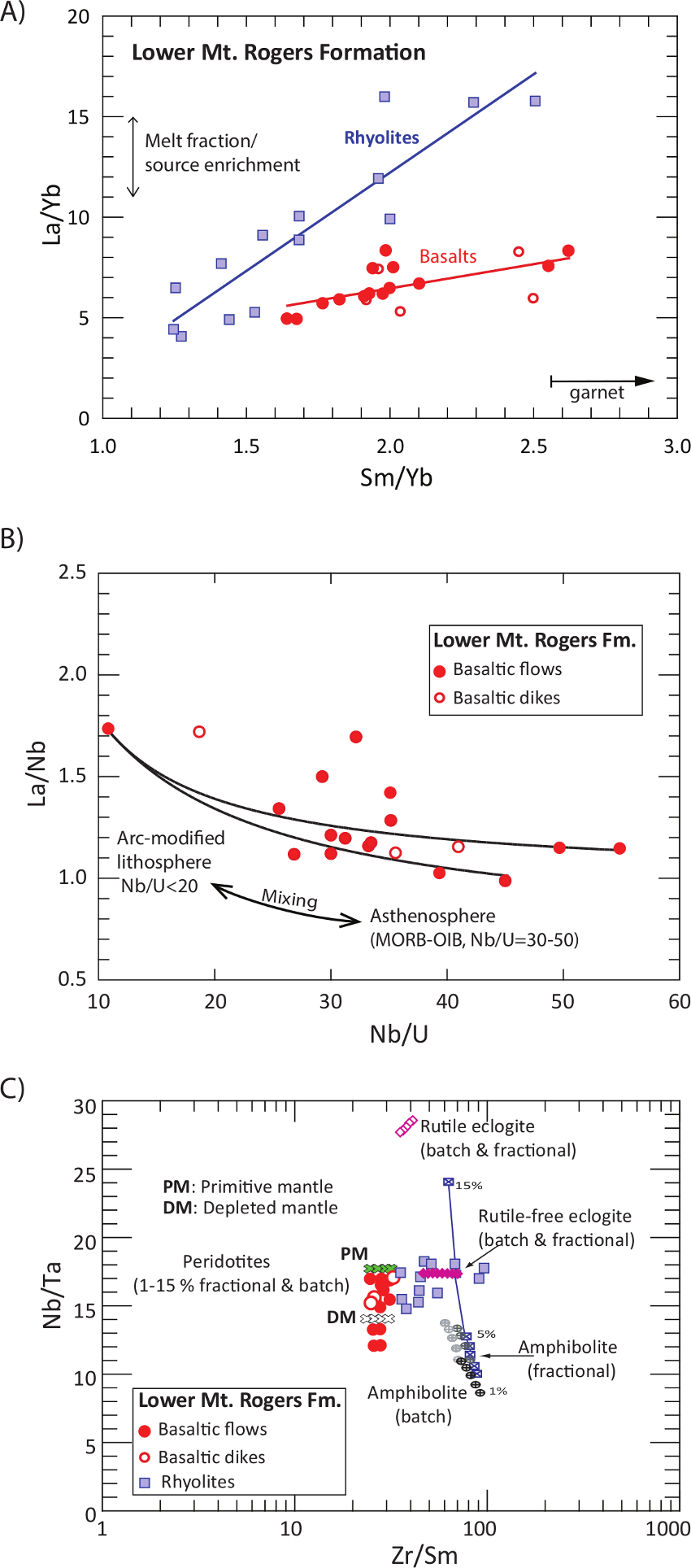
Fig. 7. Assessment of melting conditions using non-fluid mobile REE and HFSE ratios of volcanic rocks from Mt. Rogers Formation. A) Melt fraction/source enrichment and garnet in the source evaluation. In both ratios Sm as a denominator was used to simplify mixing as straight lines. Assuming that the rhyolites where produced by a similar source it is possible that they where produced by different melt fractions and mixing between the extreme end-members. The effect of melt fraction is not as obvious in the basalts, but there is evidence of higher garnet component in the residue as indicated by the increase in Sm/Yb (e.g., Green and Ringwood, 1967; Hofmann and Feigenson, 1983; Johnson, 1998). The array of data from the basalt samples can also be explained by mixing. B) La/Nb and Nb/U ratios of the Mount Rogers basalts suggest mixing (black lines) between lithospheric and asthenospheric mantle components (Hofmann et al., 1986; Hofmann, 1997). C) Possible source compositions for the volcanic samples presented in this study from Foley et al. (2002). Note that according to this diagram the basaltic samples are consistent with peridotite sources and the rhyolites are better explained by lower crust sources as rutile-free eclogite source and/or amphibolite with mixing toward mantle components, thus suggesting the interaction between mantle-derived melts and lower crust lithologies as suggested in other scenarios (e.g., Hildreth and Moorbath, 1988; Annen et al., 2006).
The rhyolite patterns have HFSE depletions (Fig. 6 D), as would be expected with crustal interaction. It is possible that the rhyolites were produced when asthenosphere-derived melts interacted with the so-called “hot zone”, a region at the boundary where basaltic melts pond and interact with the lower crust, as the samples have HREE depletions indicative of a garnet-bearing residue common in the lower crust (Hildreth and Moorbath, 1988; Annen et al., 2006). This interpretation is consistent with the Nb/Ta-Zr/Sm systematics shown in Fig. 7C (Foley et al., 2002), that suggest a mixing between mantle derived melts and melts produced by lower crustal lithologies like amphibolite and rutile-free eclogite.
Origin of the Cryogenian intracontinental rifting event
The Cryogenian episode of crustal extension has been considered to represent an initial stage of rifting or a “failed rift” that did not lead to continental separation and opening of an ocean basin (Rankin, 1993; Aleinikoff et al., 1995). Attempts to explain the mechanism of this phase of rifting, and the gap in time between it and the successful opening of Iapetus at ~ 565 Ma, include an origin as a failed arm of a triple junction (Rankin, 1976, 1993), a plume track forming a zone of crustal weakness that was exploited during the later extension (Fokin, 2003), and a rift-transform model that created fault-bounded blocks having independent extensional histories (Burton and Southworth, 2010).
Basaltic magmas from the Mount Rogers Formation were produced in an intraplate setting (Fig. 8A). Origin of the magmas by melting of an enriched mantle, combined with interaction with lithospheric mantle that was metasomatized by fluids, is suggested by the near vertical increase in Th/Yb at near constant Nb/Yb (Fig. 8B, Pearce, 2008). The Y-Nb systematics of the rhyolites coupled with Rb (a fluid mobile element) also confirms an intraplate tectonic setting for the Cryogenian event (Fig. 8C, Pearce et al. 1984). The Zr/Y-Nb/Y systematics of the basalts (Fig. 8D) suggest the requirement of a component common in modern ocean island basalts derived from recycled oceanic crust, and a deep depleted component common in large igneous provinces. Both of these components are associated with mantle plume activity throughout Earth history (Condie, 2005). This association is confirmed by the dominantly positive ΔNb (Δ Nb = -1.92log(Zr/Y) +1.740+ log(Nb/Y), Fitton et al., 1997] values of the lavas (Figure 8D) that can be explained by a mantle plume source in the production of the Cryogenian mafic lavas (Fitton et al., 1997; Jackson et al., 2008).
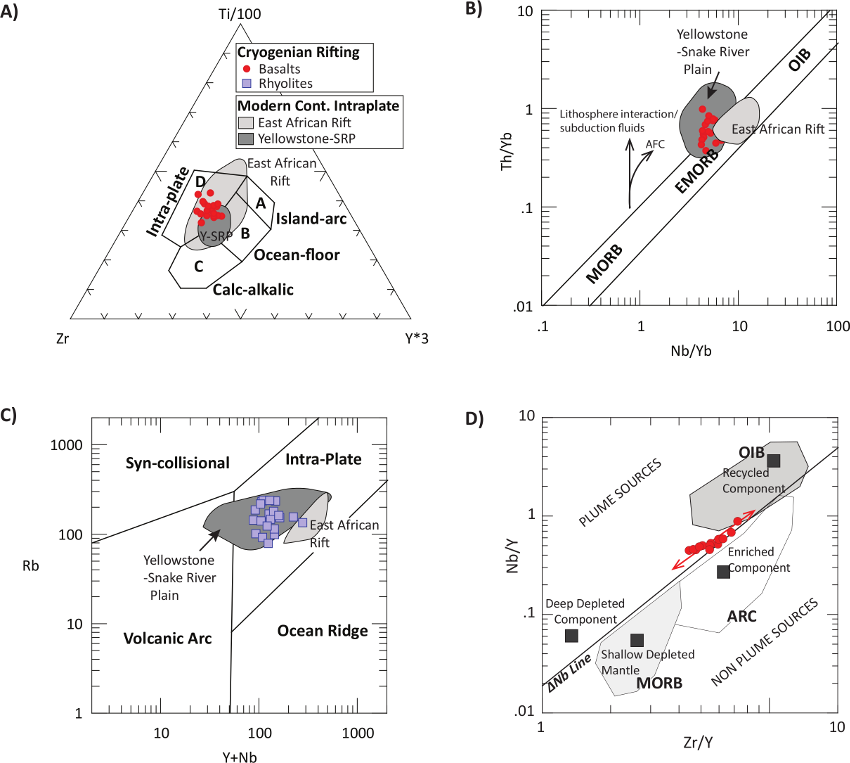
Fig. 8. Tectonic discrimination diagrams for the Mount Rogers volcanic rocks compared to modern intraplate magmas from East-African Rift and Yellowstone-Snake River Plain (SRP) (http://georoc.mpch-mainz.gwdg.de/georoc/). A) Zr-Ti-Y diagram from Pearce and Cann (1973), for basaltic rocks with CaO+MgO 12-20 wt%. Notice that the basalts from Mount Rogers plot in the intraplate area together with samples from the East African Rift and some overlap with Yellowstone-SRP basalts. B) Rb-Y+Nb diagram from Pearce et al. (1984) for granitic rocks but also widely used for rhyolites. The rhyolites clearly plot in the intraplate setting within the area defined by rhyolites from the Yellowstone-Snake River Plain (SRP). D) Plume vs non-plume components from Condie (2005) for the Mount Rogers basaltic samples consistent with the involvement of plume sources with positive ΔNb (mixing between a deep depleted component and OIB recycled component, Fitton et al., 1997).
Trace-element compositions of the MRF Cryogenian basalts and rhyolites show strong similarities with modern lavas from the East African Rift and the Yellowstone-Snake River Plain intraplate systems (Fig. 6). The rhyolites are closer to the Yellowstone samples as they also share Nb-Ta depletions suggestive of a higher degree of crustal interaction than the ones from the East African Rift, but the overall patterns are comparable to both locations. The similarity between modern magmas produced in the Yellowstone-Snake River Plain system and the Cryogenian lavas is also notable in the trace-element diagrams in Fig. 8. Geochemical, geophysical and tectonic evidence suggest that the common denominator controlling the melting processes in the East African Rift and the Yellowstone-Snake River Plane system is deep mantle plume activity (e.g, Scarci and Criag, 1996, Dodson et al., 1997; Nyblade et al., 2000; Furman, 2006; Schutt and Dueker, 2008). Applying a uniformitarianism approach to the geochemical evidence presented here, we suggest that the initial phase of extension of the eastern Laurentian margin at ~760 Ma was triggered by mantle plume activity (McClellan and Gazel, 2014). Lithospheric weakness caused by such a mantle plume, as suggested by numerical modeling in other plume-lithosphere interaction scenarios (Sobolev et al. 2011), may have triggered the later regional extension and intracontinental rifting to form the rifted margin (Fig. 9).
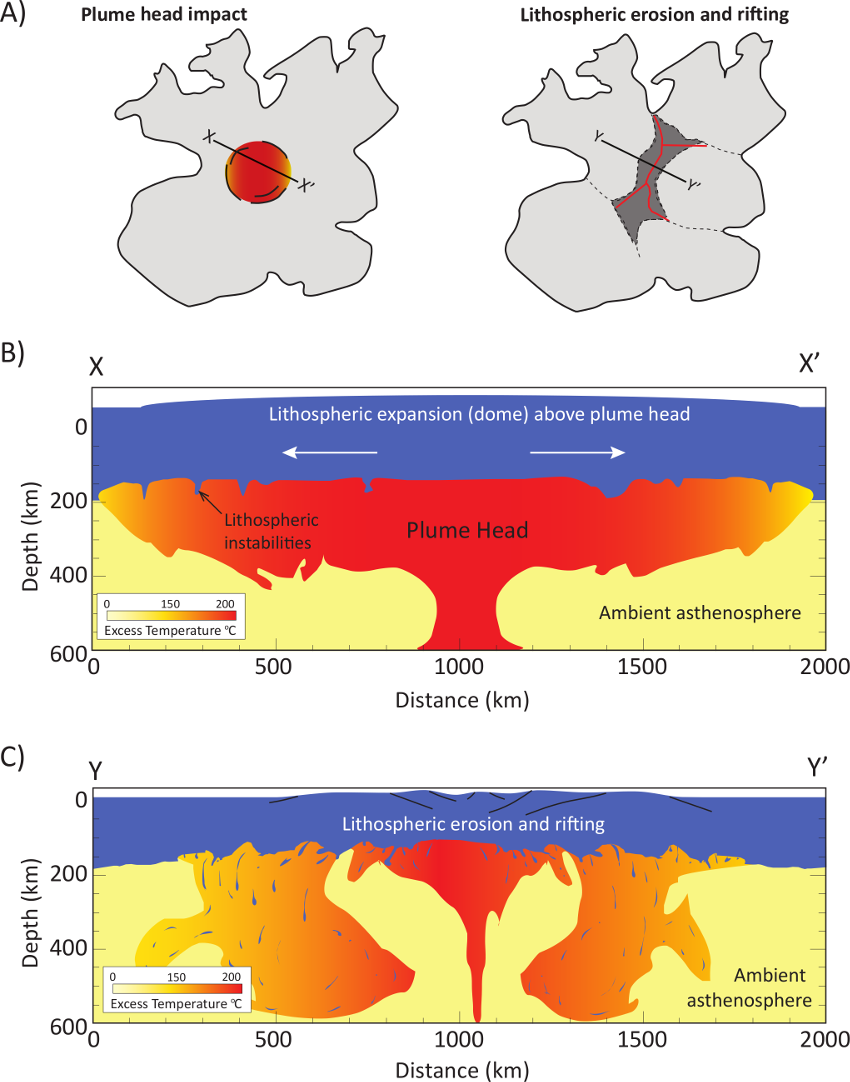
Fig. 9. Schematic model of the possible events that triggered the breakup of Rodinia, modified from Sobolev et al. (2011). A plume head impacted Rodinia producing lithospheric expansion above the plume head, followed by lithospheric spreading and erosion that evolved into rifting. Excess temperature represents temperature above ambient asthenosphere provided by the mantle plume, which in modern conditions is about 200 °C, above ambient mantle.
Temporal and spatial variations of the rifting event
Remnants of Cryogenian anorogenic magmatism that preceded breakup of Rodinia and opening of the Iapetus Ocean are exposed over a distance of >700 km in the French Broad and Shenadoah massifs (Fig. 1), and show a general pattern of younging from southwest to northeast (Fig. 1, Fig. 10). Volcanic rocks of this age are dominantly preserved in the Mount Rogers and Grandfather Mountain Formations of the French Broad massif (Fig. 1). The Grandfather Mountain Formation (GMF) comprises a thick sequence of clastic alluvial fan deposits interbedded with basalt and rhyolite (Schwab, 1977; Neton, 1992). The GMF unconformably overlies Mesoproterozoic basement that was intruded by the Neoproterozoic Brown Mountain alkali granite, and the age of the formation is constrained by U-Pb zircon ages on the underlying Brown Mountain Granite (765 ± 7Ma) and the stratigraphically highest rhyolite in the GMF (742 ± 2Ma) (Fetter and Goldberg, 1995).
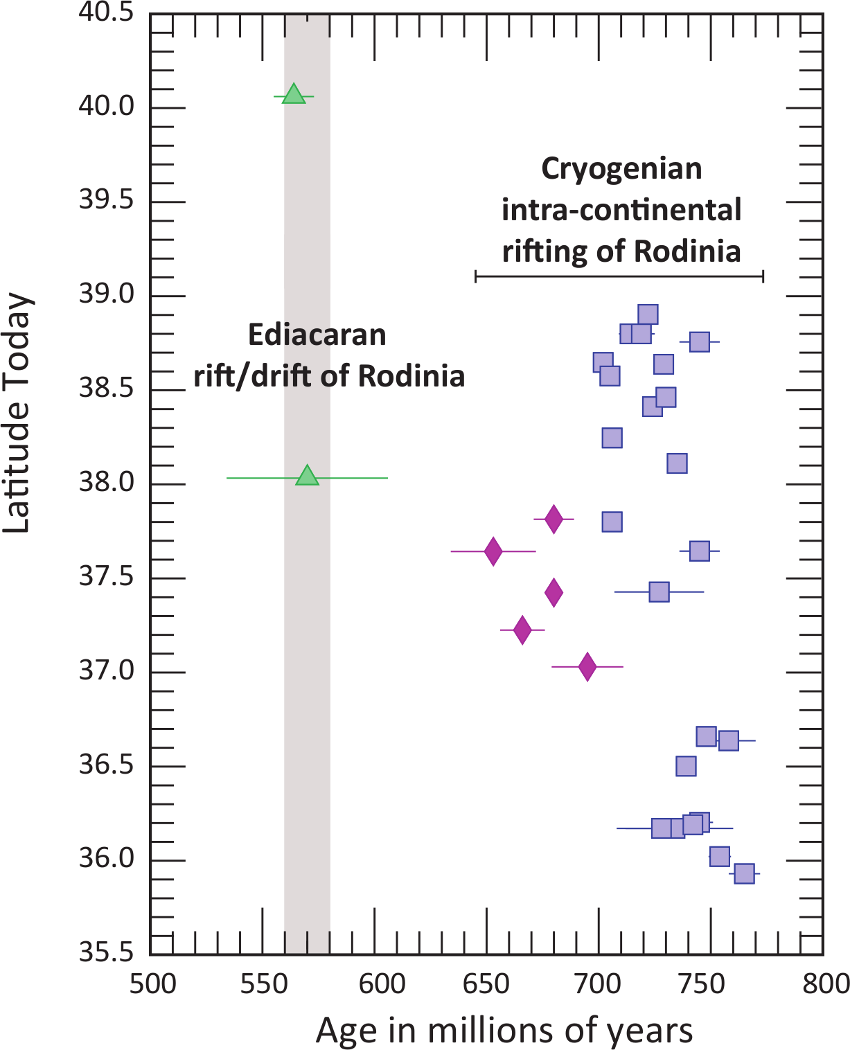
Fig. 10. Spatial variation of plutonic and volcanic events in the central and southern Appalachian Blue Ridge (French Broad and Shenandoah massifs) related to the breakup of the eastern North American margin of Rodinia, in present-day coordinates. Stage 1, Cryogenian intracontinental rifting, is represented by plutons and volcanic rocks that generally young from south to north (squares), and a regional cluster of slightly younger plutons (diamonds). Stage 2, final rift to drift transition, is represented by Ediacaran volcanic rocks of the Catoctin Formation.
Other than the Brown Mountain Granite, Cryogenian plutons in the French Broad massif range in age from ~748-739 Ma (Fig. 1), and were intruded by a suite of diabase dikes and gabbros of the Bakersville dike swarm between ~734-728 Ma (Goldberg et al., 1986; Ownby et al., 2004). Along strike in the Shenandoah massif, anorogenic granitoid plutons appear to represent two age groups. Plutons >700 Ma are concentrated in the Robertson River Igneous Suite (Tollo and Aleinikoff, 1996), whereas a small group of <700 Ma plutons are restricted to an area between latitudes 37°N - 38°N (Fig. 1, Fig. 10). With the exception of this latter group of younger plutons, magmatism in the French Broad and Shenadoah massifs generally appears to have proceeded from older to younger along strike to the northeast. In this area, there is no record of igneous activity subsequent to the youngest of the latter group of plutons (Mobley Mountain, ~653 Ma, Fokin, 2003) until outpouring of the Catoctin flood basalts (Fig. 1, Fig. 10) at ~570-565 Ma (Badger and Sinha, 1988; Aleinikoff et al., 1995), an event that corresponded to the final breakup of Rodinia and opening of the Iapetus Ocean (Wehr and Glover, 1985; Aleinikoff et al., 1995; Badger et al., 2010). Therefore, a period of >100 m.y. separated Cryogenian anorogenic magmatism and crustal extension, and the Ediacaran volcanism that marked successful rifting of the margin.
Field evidence for plume-related origin of the Cryogenian magmatic event
Li et al. (2003, 2008) assembled evidence that points to two major phases of bimodal anorogenic magmatism affecting Rodinian continental blocks, the first spanning ~ 840-790 Ma (South China, Australia, India), and the second spanning ~ 780-720 Ma (South China, Australia, India, Laurentia, and southwestern Africa). Large-scale lithospheric doming and unroofing, consistent with plume activity, accompanied or preceded these events. Recognizing that the widespread nature and duration of the magmatic events required a large, sustained heat source, they proposed the existence of a mantle superplume underneath Rodinia, which eventually led to its breakup.
Identifying evidence for plumes in the geologic past is complicated by subsequent erosion and, commonly, deformation due to later tectonic events, including continental collision. Such is the case along the eastern margin of Laurentia. Plume-related features may be preserved in the geologic record, however, and include broad domal uplifts, dike swarms, flood basalts, and intracontinental rifting and breakup (Ernst and Buchan, 2003). Significant domal uplift that precedes rifting is commonly associated with plumes (e.g., Şengör and Natal’in, 2001; Ernst and Buchan, 2003; Campbell, 2007), commonly tens of millions of years before magmatic activity (Rainbird and Ernst, 2001), and may lead to a widespread sedimentary hiatus between basement rocks and plume-related volcanics (Li et al., 2003). In the region of this study, a significant unconformity exists between Mesoproterozoic basement rocks and volcanic and sedimentary deposits of the Mount Rogers and Grandfather Mountain Formations in the French Broad massif. To the north in the Shenandoah massif, Neoproterozoic sedimentary rocks occur in the Mechum River and Swift Run Formations. Although the exact ages of these units are uncertain, a maximum depositional age for the Mechum River Formation is indicated by clasts of ~730 Ma granite of the Robertson River suite contained in conglomerates (Bailey et al., 2007). The younger Swift Run clastic rocks interfinger with basalts of the Catoctin Formation (Jonas and Stose, 1939; Southworth and Brezinski, 1996; Bailey et al., 2002); therefore both units are younger than the Mount Rogers and Grandfather Mountain Formations. Detrital zircon data for Neoproterozoic and Paleozoic sedimentary rocks of the southern and central Appalachians show a predominance of Mesoproterozoic “Grenville” ages, along with peaks at ~780 Ma and younger, but a near total absence of ages between ~900-780 Ma (e.g., Bream et al., 2004; Chakraborty et al., 2012; Holm-Denoma et al., 2012; Holm-Denoma et al., 2014; McClellan and Holm-Denoma, 2014). These data suggest considerable uplift and erosion of Mesoproterozoic basement rocks prior to extrusion of the Mount Rogers/Grandfather Mountain and related sequences, consistent with a pre-rift doming event.
In the French Broad massif, the ~ 730 Ma Bakersville mafic dike swarm intrudes Mesoproterozoic basement over an area at least 200 km long and 25 km wide. Where most densely concentrated (Fig. 1), dikes comprise up to 20-50% of the total rock mass, although 5-15% is more typical (Goldberg et al., 1986). Similar dikes are abundant in the Mount Rogers area and continue to the north end of the exposed French Broad massif (Burton and Southworth, 2010). The linear N to NNE trend of the dikes does not appear to form the radiating pattern typical of plume-related dike swarms, although the present orientation may be partially due to realignment during Paleozoic deformation. Mafic dikes are also abundant in the northern part of the Shenandoah massif; however, the chemical similarity and proximity to basalts of the Catoctin Formation suggest these are younger feeder dikes to the Catoctin basalt flows (Burton and Southworth, 2010), related to the ~565 Ma rifting and opening of the Iapetus ocean basin. Therefore, preserved Cryogenian rocks in the Shenandoah massif are dominated by granitoid plutons and rare felsic volcanics.
To the east of the Mount Rogers area, the Fries fault (Fig. 1) juxtaposes the Ashe Metamorphic Suite (Abbot and Raymond, 1984) against Mesoproterozoic basement. Amphibolite of probable volcanic origin comprises up to 50% of the Ashe (Rankin et al., 1973), and Bartholomew et al. (1983) suggested that the Bakersville dikes might have been feeders to the Ashe volcanics. On the other hand, Abbot and Raymond (1984) interpreted the Ashe as having been deposited on oceanic crust. Uncertainties concerning the age and depositional setting of the Ashe and its structural relationship with the French Broad massif therefore preclude a demonstrable correlation with the Cryogenian rift event. The true extent of Cryogenic mafic dikes and flows, as well as related felsic plutonism and volcanism, is unknown, as the rocks are overridden by Paleozoic faults on the east and buried by late Neoproterozoic to Paleozoic sediments to the west and south. The present exposure of the French Broad and Shenandoah massifs for greater than 700 km along strike (Fig. 1), however, is consistent with a plume head of ‘normal’ 1000-km radius (Ernst and Buchan, 2003) particularly if we accept that some of the evidence is buried, eroded, or perhaps exists on a rifted conjugate margin, as discussed in McClellan and Gazel (2014).
CONCLUSIONS
During Neoproterozoic breakup of Rodinia, the Eastern North American (Laurentian) margin experienced an ~200 m.y. history of rifting that occurred in two major pulses. The first magmatic episode took place over the period of ~ 765-680 Ma (possibly beginning as far back as 780 Ma, based on new dates of rhyolite clasts in conglomerate). This phase involved intracontinental rifting, characterized by bimodal volcanism and intrusion of mafic dikes and A-type granitoid plutons. In the region of this study, here appears to have been a hiatus in activity until extrusion of basalt and minor rhyolite at ~ 565 Ma, during relatively rapid extension that led to continental breakup and opening of the Iapetus Ocean.
New and existing geochemical data from rhyolites and basalts in the ~760-750 Ma Mount Rogers Formation suggest a mantle plume triggered the breakup of Rodinia, as they share geochemical signatures with recent volcanic rocks from the East African Rift and Yellowstone-Snake River Plain. The basaltic samples where produced by melting mantle sources with deep depleted and recycled components common in mantle plume samples (positive ΔNb) and the rhyolites appear to be melts that resulted from the interaction of mantle-derived melts with the lower crust.
The Cryogenian volcanic and plutonic rocks show a general pattern of younging from southwest to northeast, and a regional unconformity between Mesoproterozoic Grenville basement and the ~760-750 Ma Mount Rogers and related rocks could signal pre-rift doming and uplift. Together, the field and geochemical data are best explained by a mantle plume that impacted Rodinia at ~ 765-700 Ma, triggering the regional extension and intracontinental rifting of that preceded breakup of the Laurentian margin.
REFERENCES
Abbot, R.N., Jr., and Raymond, L.A., 1984. The Ashe Metamorphic Suite, northwest North Carolina: Metamorphism and observations on geologic history. American Journal of Science 284, 350-375.
Aleinikoff, J.N., Zartman, R.E., Walter, M., Rankin, D.W., Lyttle, P.T., and Burton, W.C., 1995. U-Pb ages of metarhyolites of the Catoctin and Mount Rogers formations, Central and Southern Appalachians; Evidence for two pulses of Iapetan rifting. American Journal of Science, 295, 428-454.
Annen, C., Blundy, J. D., and Sparks, J., S. R. S., 2006, The genesis of intermediate and silicic magmas in deep crustal hot zones: Journal of Petrology 47, 505-539.
Badger, R.L., and Sinha, A.K., 1988. Age and Sr isotopic signature of the Catoctin volcanic province: Implications for subcrustal mantle evolution. Geology 16, 692-695.
Badger, R.L., Ashley, K.T., and Cousens, B.L., 2010. Stratigraphy and geochemistry of the Catoctin volcanics: Implications for mantle evolution during the breakup of Rodinia. In: Tollo, R.P., Bartholomew, M.J., Hibbard, J.P., and Karabinos, P.M. (Eds.), From Rodinia to Pangea: The Lithotectonic Record of the Appalachian Region. Geological Society of America Memoir 206, pp. 397-415.
Bailey, C.M., and Rose, K.K., 1998. The Late Neoproterozoic Pond Mountain volcanic complex, Blue Ridge province, southern Appalachians. Southeastern Geology 37, 177-188.
Bailey, C.M., Giorgis, S., and Coiner, L., 2002. Tectonic inversion and basement buttressing: An example from the central Appalachian Blue Ridge province. Journal of Structural Geology 24, 925-936.
Bailey, C.M., Peters, S.E., Morton, J., and Shotwell, N.L., 2007. The Mechum River Formation, Virginia Blue Ridge: A record of Neoproterozoic and Paleozoic tectonics in southeastern Laurentia. American Journal of Science 307, 1-22. doi 10.2475/01.2007.01.
Bartholomew, M.J., Lewis, S.E., Wilson, J.R., and Gryta, J.J., 1983. Deformational history of the region between the Grandfather Mountain and Mountain City windows, North Carolina and Tennessee. In: Lewis, S.E. (Ed.), Geologic Investigations in the Blue Ridge of Northwestern North Carolina. Carolina Geological Society Field Trip Guidebook, Chapter 1, pp. 1-16.
Blondeau, K.M., and Lowe, D.R., 1972. Upper Precambrian glacial deposits of the Mount Rogers Formation, central Appalachians, U.S.A. Proceedings of the 24th International Geological Congress, Canada, pp. 325-332.
Bream, B.R., Hatcher, R.D., Jr., Miller, C.F., and Fullagar, P.D., 2004. Detrital zircon ages and Nd isotopic data from the southern Appalachian crystalline core, Georgia, South Carolina, North Carolina, and Tennessee: New provenance constraints for part of the Laurentian margin. In: Tollo, R.P., Corriveau, L., McLelland, J., and Bartholomew, M.J. (Eds.), Proterozoic tectonic evolution of the Grenville orogen in North America. Geological Society of America Memoir 197, pp. 459-475.
Burton, W.C., and Southworth, S., 2010, A model for Iapetan rifting based on Neoproterozoic dikes and related rocks. In: Tollo, R.P., Bartholomew, M.J., Hibbard, J.P., and Karabinos, P.M. (Eds.), From Rodinia to Pangea: The Lithotectonic Record of the Appalachian Region. Geological Society of America Memoir 206, pp. 455-476.
Campbell, I.H., 2007. Testing the plume theory. Chemical Geology 241, 153-176. doi:10.1016/j.chemgeo.2007.01.024.
Carrigan, C.W., Miller, C.F., Fullagar, P.D., Bream, B.R., Hatcher, R.D., Jr., and Coath, C.D., 2003. Ion microprobe age and geochemistry of southern Appalachian basement, with implications for Proterozoic and Paleozoic reconstructions. Precambrian Research 120, 1-36.
Chakraborty, S., Moecher, D.P., and Samson, S., 2012. Provenance of the Lower Ocoee Supergroup, eastern Great Smoky Mountains. Geological Society of America Bulletin 124, 1278-1292.
Condie, K. C., 2005, High field strength element ratios in Archean basalts: a window to evolving sources of mantle plumes?. Lithos, 79 (3-4), 491-504.
Dodson, A., Kennedy, B. M., and DePaolo, D. J., 1997. Helium and neon isotopes in the Imnaha Basalt, Columbia River Basalt Group: Evidence for a Yellowstone plume source. Earth and Planetary Science Letters 150, 443-451.
Ernst, R.E., and Bleeker, W., 2010. Large igneous provinces (LIPs), giant dyke swarms, and mantle plumes: significance for breakup events within Canada and adjacent regions from 2.5 Ga to the Present. Canadian Journal of Earth Sciences 47, 695-739.
Ernst, R.E., and Buchan, K.L., 1997. Giant radiating dyke swarms: Their use in identifying Pre-Mesozoic large igneous provinces and mantle plumes. In: Mahoney, J., and Coffin, M. (Eds.), Large Igneous Provinces: Continental, Oceanic, and Planetary Volcanism. American Geophysical Union, Geophysical Monograph Series, v. 100, p. 297-333.
Ernst, R.E., and Buchan, K.L., 2003. Recognizing mantle plumes in the geological record. Annual Review of Earth and Planetary Sciences 31, 469-523. doi: 10.1146/annurev.earth.31.100901.145500.
Essex, R.M., 1992. Age and petrogenesis of the Striped Rock Granite Pluton: Blue Ridge province, southwestern Virginia. Master’s thesis, Virginia Polytechnic Institute and State University, Blacksburg, Virginia. 98 p.
Fetter, A.H., and Goldberg, S.A., 1995. Age and geochemical characteristics of bimodal magmatism in the Neoproterozoic Grandfather Mountain rift basin. Journal of Geology, 103, 313-326.
Fitton, J.G., Saunders, A.D., Norry, M.J., Hardarson, B.S. Taylor, R.N.,1997. Thermal and chemical structure of the Iceland plume. Earth and Planetary Science Letters 153, 197-208.
Foley, S.F., Tiepolo, M., Vannucci, R., 2002. Growth of early continental crust controlled by melting of amphibolite in subduction zones. Nature 417, 837-840. DOI: 10.1038/nature00792
Fokin, M.A., 2003. Space-time analysis of magmatism: The igneous record for an Early Cryogenian plume track in central Appalachian orogen. Master’s thesis, Virginia Polytechnic Institute and State University, Blacksburg, Virginia. 67 p.
Furman T., Bryce J., Rooney T., Hanan B., Yirgu G., and Ayalew D., 2006. Heads and tails: 30 million years of the Afar plume. Journal of the Geological Society, London, 259, 97-121.
Goldberg, S.A., Butler, J.R., and Fullagar, P.D., 1986. The Bakersville dike swarm: Geochronology and petrogenesis of Late Proterozoic basaltic magmatism in the southern Appalachian Blue Ridge. American Journal of Science 286, 403-430.
Green, D.H., Ringwood, A.E., 1967. The stability filed of aluminous pyroxene peridotite and garnet peridotite and their relaevance in upper mantle structure. Earth and Planetary Science Letters 3, 151-160.
Hildreth, W., Moorbath, S., 1988. Crustal contributions to arc magmatism in the Andes of Central Chile. Contributions to Mineralogy and Petrology 98, 455-489.
Hofmann, A., 1997, Mantle geochemistry: the message from oceanic volcanism: Nature 385 (6613), 219-229.
Hofmann, A.W., Feigenson, M., 1983. Case studies on the origin of basalts: I. Theory and reassessment of Grenada basalts. Contributions to Mineralogy and Petrology 84, 382-389.
Hofmann A. W., Jochum K. P., Seufert M., and M., W. W., 1986, Nb and Pb in oceanic basalts: new constraints on mantle evolution: Earth and Planetary Science Letters 79, 33-45.
Holm-Denoma, C.S., Southworth, S., and Merschat, A., 2012. Detrital zircon geochronology of Neoproterozoic-Cambrian strata of the Appalachian Blue Ridge: Mt. Rogers, VA area. Geological Society of America Abstracts with Programs 44, 172.
Holm-Denoma, C.S., McClellan, E., and Southworth, S., 2014. Three episodes of volcanism and erosion during Neoproterozoic extension in eastern Laurentia revealed by U-Pb dating of zircon from clasts of rhyolite and detrital zircon from sedimentary rocks of the Mount Rogers Formation, southwest Virginia. Geological Society of America Abstracts with Programs 46, 90.
Jackson, M.G., Hart, S.R., Saal, A.E., Shimizu, N., Kurz, M.D., Blusztajn, J.S., Skovgaard, A.C., 2008. Globally elevated titanium, tantalum, and niobium (TITAN) in ocean island basalts with high3He/4He. Geochemistry, Geophysics, Geosystems 9, DOI: 10.1029/2007gc001876.
James, S.C., 1999. Field, petrographic, and geochemical constraints on the geologic history of the Fees Rhyolite Member: Mount Rogers Formation, Blue Ridge Province, VA. Honors thesis, College of William and Mary, Williamsburg, VA.
Jessee, M., McClellan, E.A., Yonts, J., and Gregory, S., 2012, Clast analysis and spatial variation of alluvial fan conglomerates in the Neoproterozoic lower Mount Rogers Formation, Blue Ridge, SW Virginia. Geological Society of America Abstracts with Programs, 44, 29.
Johnson, K.T.M., 1998. Experimental determination of partition coeffcients for rare earth and high-feld-strength elements between clinopyroxene, garnet, and basaltic melt at high pressures. Contributions to Mineralogy and Petrology 133, 60-68.
Jonas, A.I., and Stose, G.W., 1939. Age relation of the Precambrian rocks in the Catoctin Mountain-Blue Ridge and Mount Rogers anticlinoria in Virginia. American Journal of Science 237, 575-593.
Labails, C., Olivet, J-L., Aslanian, D., and Roest, R., 2010. An alternative early opening scenario for the Central Atlantic Ocean. Earth and Planetary Science Letters 297, 355-368.
Li, Z.X., Li, X.H., Kinny, P.D., Wang, J., Zhang, S., and Zhou, H., 2003. Geochronology of Neoproterozoic syn-rift magmatism in the Yangtze Craton, South China and correlations with other continents: Evidence for a mangle superplume that broke up Rodinia. Precambrian Research 122, 85-109.
Li, Z.X., Bogdanova, S.V., Collins, A.S., Davidson, A., De Waele, B., Ernst, R.E., Fitzsimons, I.C.W., Fuck, R.A., Gladkochub, D.P., Jacobs, J., Karlstrom, K.E., Lu, S., Natapov, L.M., Pease, V., Pisarevsky, S.A., Thrane, K., and Vernikovsky, V., 2008. Assemby, configuration, and break-up history of Rodinia: A synthesis. Precambrian Research 160, 179-210. doi:10.1016/j.precamres.2007.04.021.
Lindsey, M.M., 2010, Detailed stratigraphy and geochemistry of lower Mount Rogers Formation metavolcanic units exposed on Elk Garden Ridge, VA. Master’s thesis, University of South Florida, Tampa, Florida. 63 p. Theses and Dissertations. Paper 1698. http://scholarcommons.usf.edu/etd/1698.
McDonough, W. F., and Sun, S. S., 1995. The composition of the Earth, Chemical Geology 120, 223-253.
McClellan, E.A., Jessee, M., and Yonts, J., 2011. Detailed mapping of the lower Mount Rogers Formation, SW Virginia: Evidence for crustal instability preceding breakup of Rodinia. Geological Society of America Abstracts with Programs, 43, 629.
McClellan, E.A., All, J., Sublett, D.M., Jessee, M., and Yonts, J., 2012a, Basement-cover contact relationships between Mesoproterozoic rocks and the Neoproterozoic Mount Rogers Fm., southern Appalachian Blue Ridge. Geological Society of America Abstracts with Programs, 44, 257.
McClellan, E.A., Jessee, M., Yonts, J., and Gregory, S., 2012b. Neoproterozoic alluvial fan sedimentation in the Mount Rogers Formation, SW Virginia. Geological Society of America Abstracts with Programs, 44, 64.
McClellan, E.A., and Gazel, E., 2014, The Cryogenian intra-continental rifting of Rodinia: Evidence from the Laurentian Margin in Eastern North America. Lithos, v. 206, 321-337. DOI: 10.1016/j.lithos.2014.08.006.
McClellan, E., and Holm-Denoma, C.S., 2014. Neoproterozoic geologic history of eastern Laurentia: evidence from U-Pb dating of zircon from rhyolite clasts in the Mount Rogers Formation conglomerates, SW VA, USA. Geological Society of America Abstracts with Programs 46, 89.
McLelland, J., Daly, J.S., and McLelland, J.M., 1996. The Grenville orogenic cycle (ca. 1350-1000 Ma): An Adirondack perspective. Tectonophysics 265, 1-28.
Merschat, A.J., and Southworth, S., 2011. The Razor Ridge volcanic center and implications for the Mount Rogers and Konnarock Formations. Geological Society of America Abstracts with Programs, 43, 46.
Miller, J.M.G., 1989. Glacial and glaciolacustrine sedimentation in a rift setting: Upper Proterozoic Mount Rogers Formation, S.W. Virginia. 28th International Geological Congress Abstracts, 2, 436-437.
Neton, M.J., 1992. Late Proterozoic rifting of Laurentia: Source and deposition of conglomerate units of the Grandfather Mountain Formation, North Carolina Blue Ridge. Master’s thesis, University of Tennessee, Knoxville. 180 p.
Novak, S.W,, and Rankin, D.W., 2004. Compositional zoning of a Neoproterozoic ash-flow sheet of the Mount Rogers Formation, southwestern Virginia Blue Ridge, and the aborted rifting of Laurentia. In: Tollo, R.P., Corriveau, L., McLelland, J., and Bartholomew, M.J. (Eds.), Proterozoic tectonic evolution of the Grenville orogen in North America. Geological Society of America Memoir 197, 571-600.
Nyblade, A.A., Owens, T. J., Gurrola, H., Ritsema, J., Langston C.A., 2000. Seismic evidence for a deep upper mantle thermal anomaly beneath east Africa. Geology 28, 599-602.
Ownby, S.E., Miller, C.F., Berquist, P.J., Carrigan, C.W., Wooden, J.L., and Fullagar, P.D., 2004. U-Pb geochronology and geochemistry of a portion of the Mars Hill terrane, North Carolina-Tennessee: Constraints on origin, history, and tectonic assembly. In: Tollo, R.P., Corriveau, L., McLelland, J., and Bartholomew, M.J. (Eds.), Proterozoic tectonic evolution of the Grenville orogen in North America. Geological Society of America Memoir 197, 609-632.
Pearce, J.A., 2008. Geochemical fingerprinting of oceanic basalts with applications to ophiolite classification and the search for Archean oceanic crust. Lithos 100, 14-48.
Pearce, J.A., and Cann, J.R., 1973. Tectonic setting of basic volcanic rocks determined using trace element analysis. Earth and Planetary Science Letters 19, 290-300.
Pearce, J. A., Harris N.B.W., Tindle A. G. 1984. Trace element discrimination diagrams for the tectonic interpretation of granitic rocks. Journal of Petrology 25, 956-983, doi:10.1093/petrology/25.4.956
Puffer, J.H., 2002. A Late Neoproterozoic eastern Laurentian superplume: Location, size, chemical composition, and environmental impact. American Journal of Science 302, 1-27.
Rainbird, R.H., and Ernst, R.E., 2001. The sedimentary record of mantle-plume uplift. In Ernst, R.E., and Buchan, K.L. (Eds.), Mantle Plumes: Their Identification Through Time. Boulder, Colorado, Geological Society of America Special Paper 352, p. 227-245.
Rankin, D.W., 1970. Stratigraphy and structure of the Precambrian rocks in northwestern North Carolina. In Fisher, G.W., Pettijohn, F.J., Reed, J.C., Jr., and Weaver, K.N., eds., Studies of Appalachian geology – Central and southern. New York, Interscience Publishers, p. 227-245.
Rankin, D.W., 1976. Appalachian salients and recesses: Late Precambrian continental breakup and the opening of the Iapetus ocean. Journal of Geophysical Research 81, 5605-5619.
Rankin, D.W., 1993. The volcanogenic Mount Rogers Formation and the overlying glaciogenic Konnarock Formation – Two Late Proterozoic units in southwestern Virginia. U.S. Geological Survey Bulletin 2029, 26 p.
Rankin, D.W., Espenshade, G.H., and Shaw, K.W., 1973. Stratigraphy and structure of the metamorphic belt in northwestern North Carolina and southwestern Virginia: A study from the Blue Ridge across the Brevard fault zone to the Sauratown Mountains anticlinorium. American Journal of Science 273-A, 1-40.
Reed, J.C., Jr., 1955. Catoctin Formation near Luray, Virginia. Geological Society of America Bulletin 66, 298-336.
Rubin, A.E., and Tollo, R., 2012, Petrologic and geochemical evolution of the Late Neoproterozoic Razor Ridge volcanic center in southwestern Virginia. Geological Society of America Abstracts with Programs, 44, 64.
Schettino, A., and Turco, E., 2009. Breakup of Pangaea and plate kinematics of the central Atlantic and Atlas regions. Geophysical Journal International 178, 1078-1097.
Schutt, D.L., and Dueker, K., 2008. Temperature of the plume layer beneath the Yellowstone hotspot. Geology 36, 623.
Schwab, F.L, 1976. Depositional environments, provenance, and tectonic framework: Upper part of the Late Precambrian Mount Rogers Formation, Blue Ridge Province, southwestern Virginia. Journal of Sedimentary Research 46, 3-13.
Schwab, F.L, 1977. Grandfather Mountain Formation: Depositional environment, provenance, and tectonic setting of late Precambrian alluvium in the Blue Ridge of North Carolina. Journal of Sedimentary Petrology 47, 800-810.
Şengör, A.M., and Natal’in, B.A., 2001. Rifts of the world. Geological Society of America Special Paper 352, 389-482.
Sobolev, S.V., Sobolev, A.V., Kuzmin, D.V., Krivolutskaya, N.A., Petrunin, A.G., Arndt, N.T., Radko, V.A., Vasiliev, Y.R., 2011. Linking mantle plumes, large igneous provinces and environmental catastrophes. Nature 477, 312-316. DLOI: 10.1038/nature10385.
Southworth, S., and Brezinski, D.K., 1996. Geology of the Harpers Ferry Quadrangle, Virginia, Maryland, and West Virginia. U.S. Geological Survey Bulletin 2123. 33 p.
Southworth, S., Aleinikoff, J.N., Bailey, C.M., Burton, W.C., Crider, E.A., Hackley, P.C., Smoot, J.P., and Tollo, R.P., 2009. Geologic map of the Shenandoah National Park region, Virginia: U.S. Geological Survey Open-File Report 2009-1153, 96 p., 1 plate, scale 1:100,000.
Su, Q., Goldberg, S.A., and Fullager, P.D., 1994. Precise U-Pb ages of Neoproterozoic plutons in the southern Appalachian Blue Ridge and their implications for the initial rifting of Laurentia. Precambrian Research 68, 81-95.
Sun, S-S., McDonough, W.F., 1989. Chemical and isotopic systematics of oceanic basalts: Implications for mantle compositions and processes. In: Saunders, A.D., Norry, M.J. (Eds.). Magmatism in the Ocean Basins. Geological Society 42, 313-345.
Tollo, R.P., and Aleinikoff, J.N., 1996. Petrology and U-Pb geochronology of the Robertson River Igneous Suite, Blue Ridge province, Virginia – Evidence for multistage magmatism associated with an early episode of Laurentian rifting. American Journal of Science 296, 1045-1090.
Tollo, R.P, Corriveau, L., McLelland, J., and Bartholomew, M.J., 2004a. Proterozoic tectonic evolution of the Grenville orogen in North America: An introduction, in: Tollo, R.P., Corriveau, L., McLelland, J., and Bartholomew, M.J. (Eds.), Proterozoic tectonic evolution of the Grenville orogen in North America. Geological Society of America Memoir 197, p. 1-18.
Tollo, R.P, Aleinikoff, J.N., Bartholomew, M.J., and Rankin, D.W., 2004b. Neoproterozoic A-type granitoids of the central and southern Appalachians: Intraplate magmatism associated with episodic rifting of the Rodinian supercontinent. Precambrian Research 128, 3-38.
Tollo, R.P., Aleinikoff, J.N., Wooden, J.L., Mazdab, F.K., A.P., Southworth, S., and Fanning, C.M., S., 2010, Thermomagmatic evolution of Mesoproterozoic crust in the Blue Ridge of SW Virginia and NW North Carolina: Evidence from U-Pb geochronology and zircon geothermometry. In: Tollo, R.P., Bartholomew, M.J., Hibbard, J.P., and Karabinos, P.M. (Eds.), From Rodinia to Pangea: The Lithotectonic Record of the Appalachian Region. Geological Society of America Memoir 206, p. 859-896.
Tollo, R.P., Aleinikoff, J.N., Mundil, R., Southworth, C.S., Cosca, M.A., Rankin, D.W., Rubin, A.E., Kentner, A.E., Parendo, C.A., and Ray, M.S., 2012, Igneous activity, metamorphism, and deformation in the Mount Rogers area, SW Virginia and NW North Carolina. In Eppes, M.C., and Bartholomew, M.J. (Eds.), From the Blue Ridge to the Coastal Plain: Field Excursions in the Southeastern United States: Geological Society of America Field Guide 29, p. 1-66.
Wehr, F., and Glover, L. III, 1985. Stratigraphy and tectonics of the Virginia-North Carolina Blue Ridge: Evolution of a late Proterozoic-early Paleozoic hinge zone. Geological Society of America Bulletin 96, 285-295.
Whitney, D.L., and Evans, B.W., 2010. Abbreviations for names of rock-forming minerals. American Mineralogist 95, 185-187.
Wilson, J.T., 1966. Did the Atlantic close and then re-open? Nature 211, 676-681. doi:10.1038/211676a0.
Zimmer, M.M., Plank, T., Hauri, E.H., Yogodzinski, G.M., Stelling, P., Larsen, J., Singer, B., Jicha, B., Mandeville, C., Nye, C.J., 2010. The role of water in generating the calc-alkaline trend: New volatile data for Aleutian magmas and a new tholeiitic index. Journal of Petrology 51, 2411-2444.
